
Cass Gilbert was an American architect. An early proponent of skyscrapers, his works include the Woolworth Building, the United States Supreme Court building, the state capitols of Minnesota, Arkansas, and West Virginia, the Detroit Public Library, the Saint Louis Art Museum and Public Library. His public buildings in the Beaux Arts style reflect the optimistic American sense that the nation was heir to Greek democracy, Roman law and Renaissance humanism. Gilbert's achievements were recognized in his lifetime; he served as president of the American Institute of Architects in 1908–09.

The New Haven Green is a 16-acre (65,000 m2) privately owned park and recreation area located in the downtown district of the city of New Haven, Connecticut, United States. It comprises the central square of the nine-square settlement plan of the original Puritan colonists in New Haven, and was designed and surveyed by colonist John Brockett. Today the Green is bordered by the modern paved roads of College, Chapel, Church, and Elm streets. Temple Street bisects the Green into upper (northwest) and lower (southeast) halves.
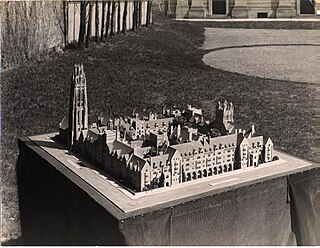
The Memorial Quadrangle is a residential quadrangle at Yale University in New Haven, Connecticut. Commissioned in 1917 to supply much-needed student housing for Yale College, it was Yale's first Collegiate Gothic building and its first project by James Gamble Rogers, who later designed ten other major buildings for the university. The Quadrangle has been occupied by Saybrook College and Branford College, two of the original ten residential colleges at Yale. The collegiate system of Yale University was largely inspired by the Oxbridge model of residential and teaching colleges at the University of Oxford and the University of Cambridge in the UK.

Sterling Memorial Library (SML) is the main library building of the Yale University Library system in New Haven, Connecticut, United States. Opened in 1931, the library was designed by James Gamble Rogers as the centerpiece of Yale's Gothic Revival campus. The library's tower has sixteen levels of bookstacks containing over 4 million volumes. Several special collections—including the university's Manuscripts & Archives—are also housed in the building. It connects via tunnel to the underground Bass Library, which holds an additional 150,000 volumes.

The Cleveland Public Library is a public library system in Cleveland, Ohio. Founded in 1869, it had a circulation of 3.5 million items in 2020. It operates the Main Library on Superior Avenue in downtown Cleveland, 27 branches throughout the city, a mobile library, a Public Administration Library in City Hall, and the Ohio Library for the Blind and Physically Disabled. The library replaced the State Library of Ohio as the location for the Ohio Center for the Book in 2003.
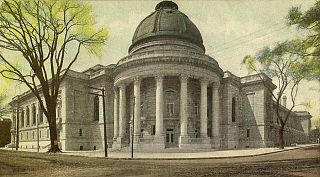
Woolsey Hall is the primary auditorium at Yale University, located on the campus' Hewitt Quadrangle in New Haven, Connecticut. It was built as part of the Bicentennial Buildings complex that includes the Memorial Rotunda and the University Commons, designed by the firm Carrère and Hastings for the Yale bicentennial celebration in 1901. With approximately 2,650 seats, it is the university's largest auditorium and hosts concerts, performances, and university ceremonies including the annual freshman convocation, senior baccalaureate, and presidential inaugurations. The building is named for Theodore Dwight Woolsey, President of Yale from 1846 through 1871.

The San Francisco Public Library is the public library system of the city and county of San Francisco. The Main Library is located at Civic Center, at 100 Larkin Street. The library system has won several awards, such as Library Journal's Library of the Year award in 2018. The library is well-funded due to the city's dedicated Library Preservation Fund that was established by a 1994 ballot measure. The Preservation Fund was renewed twice, by ballot measures in 2007 and 2022.
The Chapel Square Mall was a shopping mall in downtown New Haven, Connecticut. It was one of the first fully enclosed air-conditioned downtown malls in the United States; it has now been converted into apartments.

T. B. Blackstone Memorial Library is a building that is part of the Chicago Public Library System and is named after Timothy Blackstone. The building was designed by Chicago architect Solon S. Beman. It is now known as the Chicago Public Library – Blackstone Branch and commonly referred to as Blackstone Library, or Blackstone Branch and sometimes Blackstone for short. The Concord Granite building's two-year construction started in 1902, and it was dedicated on January 8, 1904. Blackstone Library marks the beginning of the Chicago Branch Library System as the first dedicated branch in the system. Blackstone is also the only branch of the 79-branch Chicago Public Library branch system that was constructed using private funding. The Blackstone Library was designated as a Chicago Landmark.

The Detroit Public Library is the second largest library system in the U.S. state of Michigan by volumes held and the 21st-largest library system in the United States. It is composed of the Main Library on Woodward Avenue, which houses the library's administration offices, and 23 branch locations across the city. The Main Library is part of Detroit's Cultural Center Historic District listed in the National Register of Historic Places adjacent to Wayne State University campus and across from the Detroit Institute of Arts.

The Stephen A. Schwarzman Building, commonly known as the Main Branch, 42nd Street Library or the New York Public Library, is the flagship building in the New York Public Library system in the Midtown Manhattan neighborhood of New York City. The branch, one of four research libraries in the library system, contains nine separate divisions. The structure contains four stories open to the public. The main entrance steps are at Fifth Avenue at its intersection with East 41st Street. As of 2015, the branch contains an estimated 2.5 million volumes in its stacks. The building was declared a National Historic Landmark, a National Register of Historic Places site, and a New York City designated landmark in the 1960s.
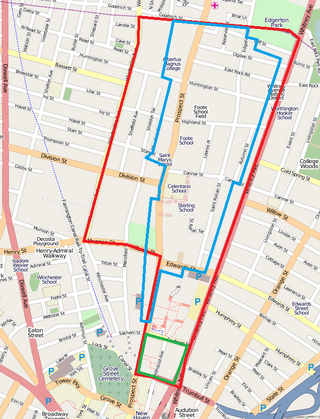
Prospect Hill is a neighborhood of the city of New Haven, Connecticut located in the north central portion of the city, directly north of Downtown New Haven. The neighborhood contains residences, institutional buildings of Albertus Magnus College and a portion of the main campus of Yale University, including the Science Hill area, the Hillhouse Avenue area and the Yale Peabody Museum. The City of New Haven defines the neighborhood to be the region bounded by the town of Hamden in the north, Winchester Avenue in the west, Munson Street/Hillside Place/Prospect Street in the southwest, Trumbull Street in the south, and Whitney Avenue in the east. Prospect Street is the main thoroughfare through the neighborhood.

The Hartford Public Library serves the city of Hartford, Connecticut, United States. The library's main branch is located at 500 Main Street in downtown Hartford. The nine branch locations are named Albany, Barbour, Blue Hills, Camp Field, Dwight, Goodwin, Mark Twain, Park and Ropkins. All branches feature free public access computers and free Wi-Fi.

Toledo Lucas County Public Library is a public library system located in Toledo, Ohio.
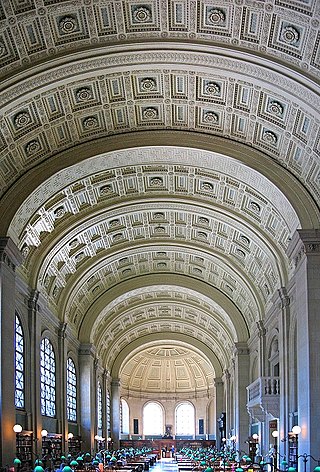
The McKim Building is the main branch of the Boston Public Library at Copley Square in Boston, Massachusetts. The building, described upon its 1895 opening as a "palace for the people", contains the library's research collection, exhibition rooms, and administrative offices. The building includes lavish decorations, a children's room, and a central courtyard surrounded by an arcaded gallery in the manner of a Renaissance cloister. The library regularly displays its rare works, often in exhibits that will combine works on paper, rare books, and works of art. Several galleries in the third floor of the McKim building are maintained for exhibits.

James Blackstone Memorial Library is a public library located in Branford, Connecticut. It is commonly referred to as the Blackstone Library or the Branford Library. The library was commissioned by Timothy Blackstone as a memorial to his father, James Blackstone. It was designed by Chicago architect Solon Spencer Beman. Construction on the building began in 1893 and was completed in 1896. The building was dedicated on June 17, 1896.

The Hartford Times Building is an architecturally significant, early 20th-century Beaux-Arts style building in downtown Hartford, Connecticut, completed in 1920 as the headquarters of the now defunct Hartford Times. The newspaper commissioned architect Donn Barber, who had designed the nearby Travelers Tower and Connecticut State Library and Supreme Court Building, to design a new structure to house its office and newspaper plant. At the time the paper was at the height of its influence with the top circulation in the state in 1917.
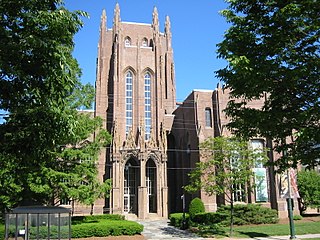
The Peabody Museum of Natural History at Yale University is one of the oldest, largest, and most prolific university natural history museums in the world. It was founded by the philanthropist George Peabody in 1866 at the behest of his nephew Othniel Charles Marsh, an early paleontologist. The museum is best known for the Great Hall of Dinosaurs, which includes a mounted juvenile Brontosaurus and the 110-foot-long (34 m) mural The Age of Reptiles. The museum also has permanent exhibits dedicated to human and mammal evolution; wildlife dioramas; Egyptian artifacts; local birds and minerals; and Native Americans of Connecticut.

Nicola D'Ascenzo was an Italian-born American stained glass designer, painter and instructor. He is best known for creating stained glass windows for the Washington Memorial Chapel in Valley Forge, Pennsylvania; the Nipper Building in Camden, New Jersey; the Loyola Alumni Chapel of Our Lady at Loyola University Maryland; the Folger Shakespeare Library and Washington National Cathedral, both in Washington, D.C.
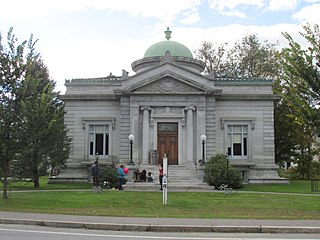
William H. McLean was an American architect from Boston, Massachusetts. He is best known for the design of public libraries, many of which he designed as a member of the firm of McLean & Wright.




















